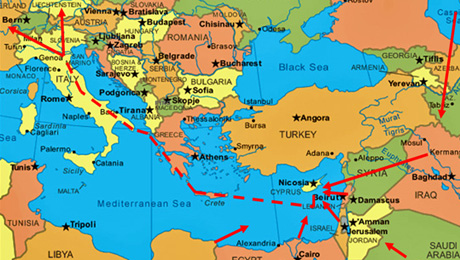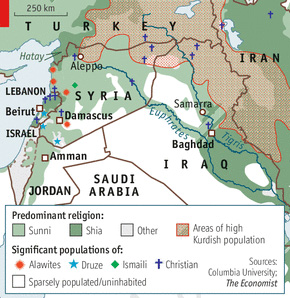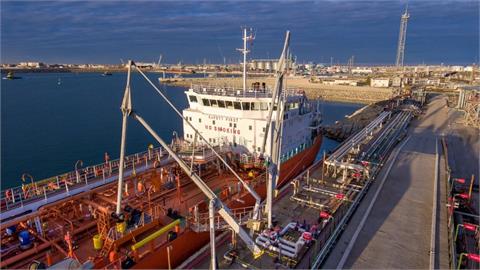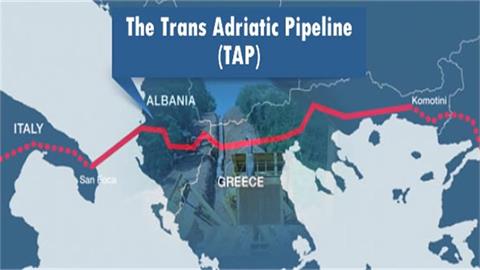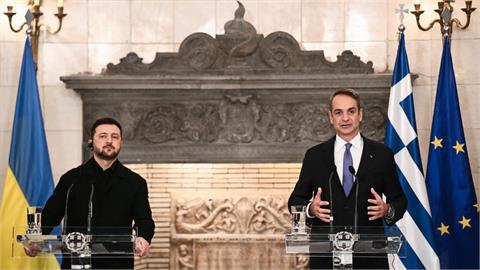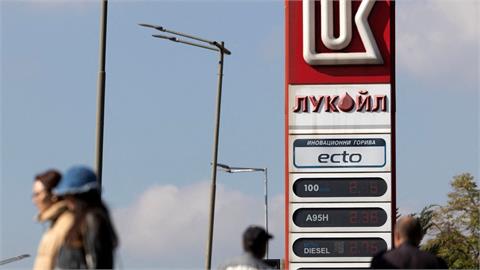In 2009, the year of the last dispute between Ukraine and Russia which lead to a European crisis, almost 80% of EU’s natural gas imports came from just three countries (Russia, Norway and Algeria).
In 2009, the year of the last dispute between Ukraine and Russia which lead to a European crisis, almost 80% of EU’s natural gas imports came from just three countries (Russia, Norway and Algeria). Similarly, almost 60% of EU crude oil imports in 2009 were originating from almost the same three countries (Russia, Norway and Libya), whilst almost 80% of hard coal imports came from just four countries (Russia, Colombia, South Africa and the United States). As long as Europe remains dependent on large scale energy imports from a limited number of suppliers, energy security will remain a major concern.
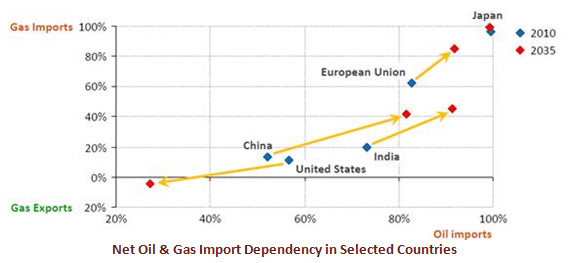
The case of Ukraine and the fact that 80% of Russian gas to Europe is transported through pipelines across Ukrainian soil showed in the clearest of ways that energy corridors should never be placed over a limited geographical area even though the supplier or transit countries are considered to be reliable. To counteract this predicament, EU plans to build an efficient energy infrastructure and promote greater interconnectedness between its member countries and external suppliers as an important component of its energy strategy. The Nord Stream pipeline, South Gas Corridor projects, gas and electricity interconnection projects across Europe were born in the above framework in order to spread risk and secure energy supplies.
The Outcomes of the Arab Spring
However, following the outbreak of the so called "Arab Spring” with several uprisings in many Arab countries, it became evident once more that the need of secure energy supply routes is more than a regional problem, but has major political connotations of global significance. It was amply demonstrated that big energy infrastructure projects such as oil and gas pipelines, LNG terminals, electricity grids, refineries, although they are key components for the smooth energy supply process between countries, could not in the case of political turmoil ensure uninterrupted energy flows (e.g. see collapse of Libyan oil production, vulnerability of Suez canal and SUMED pipeline, almost collapse of Egypt’s electricity grid etc.). In that sense it is important to have in place a diversified network of energy routes in order to secure the unhindered flow of energy.
Whether or not it could be seen as regional a shift towards a real democratic process or a setback towards an Islamic Middle Age, the Arab Spring created deep socio-political turbulence in the countries of Middle East and North Africa and gave rise to steep economic imbalances. Politics apart the Arab Spring took its toll on energy prices as once again geopolitical risk started to be discounted by both traders and companies. In 2011, the price of oil climbed to $126, almost a 25% jump compared to 2010 average price, amid unrest in parts of the Middle East and the shutdown of supplies from Libya, while in June 2011, after OPEC ignored calls from the IEA to pump more oil to keep prices in check, the agency released 60 million barrels of oil from its strategic reserve. Now, almost two and half years after the first protests in Tunisia, that marked the beginning of Arab Spring, and with continuing unrest in Syria and growing political uncertainty in Egypt, the price of Brent steadily trades well above 100 dollars per barrel over the last two months.
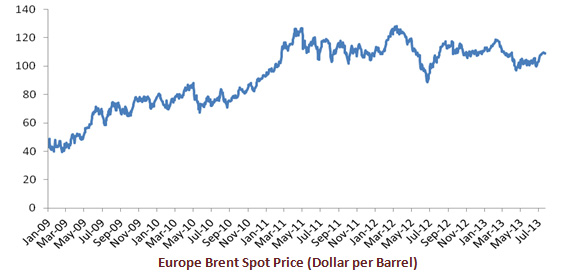
According to the International Energy Agency (IEA), oil production recovered faster than expected from the "Arab spring” but the delayed impact of the revolutions that swept across North Africa is now hurting supply growth forecasts for Egypt, Libya, Algeria and Nigeria.
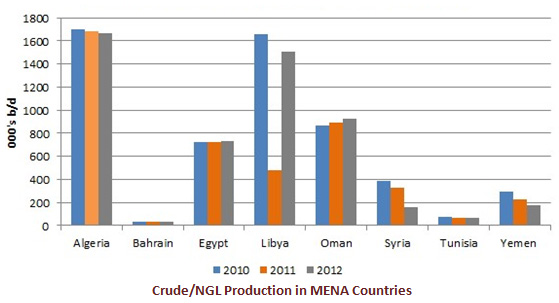
It is thus important to understand the delayed impact of the Arab Spring – which following latest events in Egypt is politically still evolving – in terms of global supplies and OPEC’s policies. The IEA anticipates that oil production from Africa’s OPEC members, namely Algeria, Angola, Libya and Nigeria will stagnate over the next five years at 7.12m barrels a day, posting virtually zero growth from 2012 to 2018. This bearish outlook for OPEC’s African members comes on the back of higher security risks in the wake of the Arab spring, uncompetitive fiscal terms, challenging local content requirements and contract sanctity concerns.
Qaddafi may have departed the scene in Libya and Mubarak in Egypt, but the situation on the ground is deteriorating. Both share energy issues as major components. In Libya, the issue is who controls the flow of oil and, to a lesser extent, natural gas. The country remains one of the last major sources of highly desired light sweet crude in the world. The recent spate of violence in Libya, targeting the oil industry, has further raised the alarm in the industry with the situation there deteriorating rapidly.
The other primary producer is Nigeria. Unfortunately, that Western African nation is moving again into civil strife, with Al Qaida groups in the north waging a war of terror while the Delta region in the south descends into wide spread violence once again. Consequently, the attack on the In Amenas gas field in Algeria in January 2013 has, in particular, prompted international oil companies to review how they operate in North Africa.
The Case of Egypt
On the other hand the crisis in Egypt is of a quite different variety. There, despite encouraging reserves of natural gas (especially in the Nile Delta offshore region), the country is experiencing massive power shortages. Officials are now openly talking about a network-wide collapse of the national grid. Political instability in Egypt after the ousting of former president Mohament Morsi, in the beginning of July, has pushed Brent prices to a three-month high. However, what’s more worrisome for global supply is the potential for Cairo’s troubles to drag on and spread across the country and beyond, specifically to the Suez Canal. Every day through the Suez region some 4 million barrels of oil pass while an additional 1.5 million barrels goes through the Suez – Mediterranean pipeline (SUMED), making any disruption a challenge of far greater importance than just for Cairo.
So far, shipments have continued on schedule, with government representatives promising that the Canal is secure, but Egypt has recently struggled with keeping the peace in the area around the Suez Canal, as well as the country’s volatile eastern Sinai Peninsula. In the two years since Mubarak was forced from office, Egyptian gas pipelines bound for Israel and Jordan were halted about 15 times following attacks by local militant groups. While the country unilaterally suspended deliveries to Israel, any further disruption could add unneeded stress in Jordan, which looks to Egypt for a sizable amount of its energy needs, not to mention a cut into vital export revenue for Cairo.
Beyond the immediate problems that energy chaos poses for Egypt and those working there — including big oil companies which reckon Cairo owes them more than $5bn — the disarray plays a major part in holding back investment in a range of industries that Egypt badly needs to create jobs and prosperity. Failure to correct it could prolong a vicious cycle of unrest and insecurity. "It’s a total mess,” said an industry source involved in one of Egypt’s most important energy infrastructure projects. "It seems like no one is making decisions.” A $250mn project to install a floating terminal to import LNG was launched last year (2012). It should have been finished but everything is stopped. Moreover, large projects, such as BP’s massive offshore West Nile Delta fields, have been delayed and output goals have been pushed back. Egypt which produces some 700,000 barrels of crude per day, became a net oil importer in 2008 following a misguided policy of massive fuel subsidies to the local consumers. Meanwhile, its population is growing at more than 2% a year and now stands at 84mn. Equally worrying from an energy policy viewpoint is Egypt’s turnaround in becoming a net importer of natural gas after years of being an exporter.
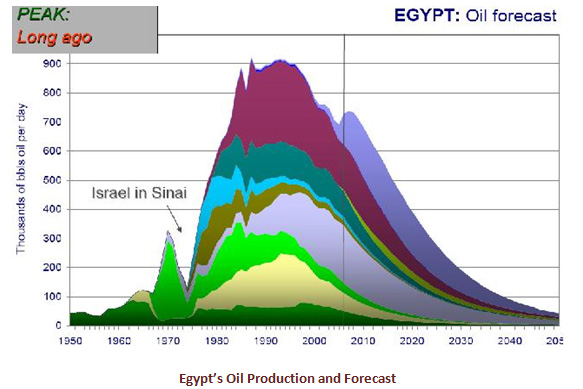
In a geopolitical framework after Mubarak’s fall, Egypt which represented a factor of stability in the region and an Islamic oasis for Israel within the desert of anti-Semitic Arab states, started loosing this significant appeal and its role as a regional stabiliser, a position supported strongly by United States. In 2012 Egypt ended a deal to ship gas to Israel allegedly over a payment dispute but in reality following Islamist’s decision impose sanctions on account of the Palestinian issue. Israeli officials responded by warning that the termination cast a strong shadow over the bilateral peace treaty.
The gas deal, signed in 2005, had provided Israel with a crucial source of fuel. Before the disruptions, Egypt was providing Israel’s electric utility with 40 percent of its natural gas, which makes up about a third of its total fuel needs. The Israeli Foreign Ministry has described the agreement as an "important and central element in the bilateral economic relationship.” Other Israeli officials played down the potential economic impact, alluding to recent discoveries of natural gas off Israel’s coast. The ex-minister of energy, Uzi Landau, said that Israel had been preparing two years now for the possibility of a cut in gas supplies from Egypt. "Israel is working to strengthen its energy independence,” said the minister. Israel has started to realize that within this polarizing situation of the Islamic world, it had already lost two of its important allies, Egypt and Turkey (following the Mavi Marmara incident) and it should accordingly modify its energy diplomacy, by developing alternative energy routes and supplies.
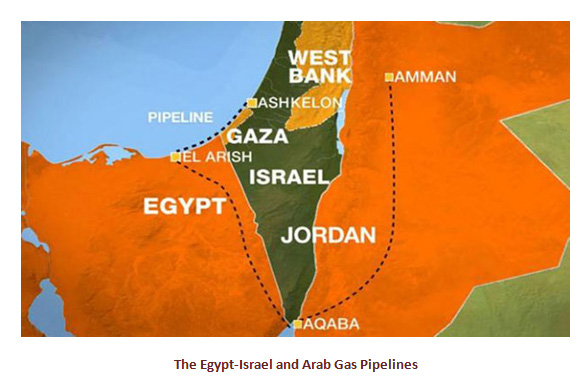
The Civil War in Syria and its Effect in the Region
Following Egypt’s latest destabilization and continuing disturbances in Libya and hence the dislocation of important energy pillars in the region, Syria’s escalating bloody conflict has created further uncertainly on the supply front. While Syria is not a major oil producer, investors fear that the two-year-old civil war could spill over to neighbouring countries and eventually affect oil supplies in the whole region. On the one hand we have the Sunni lead Saudi Arabia, which officials believe is one of the main suppliers of arms to the rebels, which is the world's largest oil producer, and on the other we have Shiite Iran, that supports the Assad regime, and which was a major oil exporter before heightened U.S. and European Union sanctions crippled exports last year. Syria’s conflict has revealed and reconfirmed the great religious divide of the Islamic world between the two main doctrines of Shiites and Sunnis.
By all counts Syria’s volatile environment, even if the Assad regime finally ends up controlling once again the majority of the country’s land area, will continue for sometime to be a source of concern and regional instability. With two of the world’s great powers Russia and China fully backing President Bashar Assad and his government and with Iran providing steady military and logistics support through Hezbollah as well as oil, though Iraq, the chances are that the Anglo – Saxon alliance (having foolishly accepted support from Gulf states, which alas comes along with Islamic Sunni militants and Al-Qaeda sympathisers) will keep for the moment away. Hence president Obama’s hesitation for USA to get militarily involved in the region is justified. But this will only be a temporary forced retreat in the sense that USA, UK and French interests will continue to have their sights firmly set on Iraq and the yet to be born new Kurdistan state. An open conflict between all the above in Syria’s devastated countryside may have been avoided for the time being but the tensions will persist for some considerable time to come. The prize of the much vaunted hydrocarbon deposits of the broader area is simply too enormous to be ignored that easily. As it is mentioned in the attached note the "Fertile Croissant” borrowed from The Economist (see box), Britain and France had long ago agreed to split the Fertile Crescent (i.e. Syria-Iraq) between them on account of its vast hydrocarbon deposits.
Fertile Croissant
Did Winston Churchill hiccup or sneeze? Either way, the story goes, the pen in his hand slipped on the map, leaving Jordan’s eastern border sharply indented. Like many legends, this holds a kernel of truth. Many Arab frontiers reflect not natural or human boundaries but the whims and fears of the imperialists who drew them up.
As colonial secretary in 1921, Churchill might have lopped off more of Jordan, but he wanted to keep control of an air corridor to another British protectorate, Iraq, where the Royal Air Force was dropping poison gas on rebellious Arab tribes. In 1916, in the middle of the first world war, Britain and France had signed a secret pact, the notorious Sykes-Picot agreement (named after the British and the French diplomats who negotiated it), to split the Fertile Crescent between them. A northern slice, running from the Mediterranean to the Tigris river, went to France; a southern slice, from Palestine to Iraq, was bagged by Britain. Both had reason to be happy. The Catholic church had been nagging for French control of the Syrian coast, home to many Maronite Catholics, and Britain was keen to put the French between them and the Russians to the north.
Their carve-up of the Ottoman empire might have been worse. Unsure at first what to do with Palestine, they considered giving it to Belgium. Instead, Arthur Balfour, Britain’s foreign secretary, in 1917 issued a declaration promising a "national home for the Jewish people” in Palestine. Like Churchill and Sykes, Balfour quietly favoured steering Jews away from British shores. Wartime British officials also sought to please influential Zionists in America, as well as Russian Bolsheviks.
France did slice Lebanon out of Syria, aiming to create a Christian-dominated republic, and in the 1920s briefly considered giving a coastal state to the Alawites and an inland one to the Druze. France and Britain also backed the formation of a Kurdish state at the Treaty of Sèvres in 1920, but they refused to allow "their” Kurds in Iraq and Syria to join it. The idea fizzled, leaving today’s 25m Kurds as the globe’s largest people without a state. But in 1938 France donated a chunk of Syria, now known as Hatay, to Turkey. Hatay’s Turkish minority had been lobbying more effectively than the rest of the population, mostly Arabic-speaking, who wanted to remain in Syria.
Now, with Syria again fracturing into warring parts, Iraq threatening to follow suit and cracks beginning to show in Lebanon, the borders drawn up nearly a century ago are starting to look frayed. Syria’s dispersed Kurds are now meeting as refugees in the Kurdish autonomous zone in northern Iraq. The closely related Sunni Arab tribes of the Euphrates valley, sliced in two by Messrs Sykes and Picot, are uniting again, this time to face Shia oppressors. And to the west, perhaps, that stillborn Alawite state is about to rise again.
From The Economist, July 13, 2013
If the Syrian conflict is not soon resolved there is a strong possibility for the country to be divided into three regions of influence, corresponding to the prevailing religious groups and ethnicities, i.e. Sunnis, Alawites (Shiites) and Kurds. According to political analysts Iraqi Sunnis may join the Syrian Sunnis leading to division of Syria based on religious and ethnic forces and finally this "religious tsunami” may hit Lebanon and Jordan.
Most political observers now agree that Syria is gradually breaking into three. The forces of Mr Assad recently seized the initiative but they cannot defeat outright the opposition and instead are consolidating their grip on the western spine of the country. From Damascus and Homs to Hama and Latakia, the regime is carving out a coastal state. Meanwhile, the rebels are doing the same in the Euphrates valley stretching from Turkey to Iraq through open desert. On July 22nd they took over Khan al-Asal, a town close to Aleppo, a divided northern city. As extreme Islamist elements among the rebels gain in strength, rumours abound that al-Qaeda-related groups will declare a religious state. Already, black flags can be seen flying above mini-emirates.
On the other hand, the Kurdish factor is emerging as another important component regarding the role that Syria plays in the region. Kurdish groups are using the chaos of the civil war to create an autonomous region. Kurdish fighters have seized control of an area in Northeast Syria on the border with Turkey and Iraq and are battling Islamist rebel groups linked to Al Qaeda for control of oilfields in the northeast of the country.
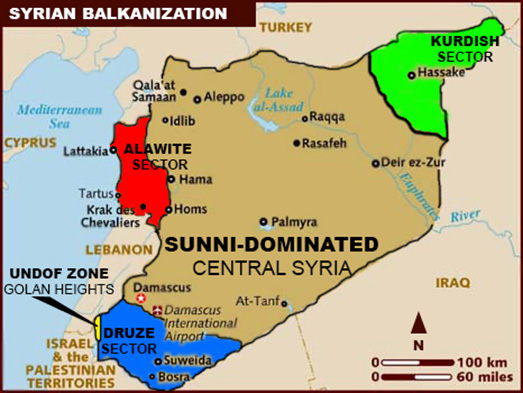
In the middle of July, the Democratic Union Party, the Syrian branch of Turkey’s Kurdistan Workers Party (PKK), announced a constitution and a plan to elect a council to administer the area known as Rojava or west Kurdistan. Exactly a year ago they took over policing the area and in early July they kicked out jihadists from the border town of Ras al-Ain. The capture of Ras al-Ain by the Democratic Union Party (PYD), a Syrian Kurdish party with links to Kurdish militants in Turkey, rang alarm bells in Ankara. The Turkish government fears the emergence of an autonomous Kurdish region in Syria could embolden home-grown militants of the Kurdistan Workers’ Party (PKK), which is fighting for autonomy in Turkey and thus threaten the latest peace initiative of the Erdogan’s government.
As can be seen in the above map Syria can play a decisive role in the region’s geopolitical stability as it borders with major oil and gas producers and consumers but also with equally unstable political environments (i.e. Egypt, Lebanon) and therefore is bound to have a significant impact on energy security issues. The EIA, in its country review for 2012, said that while Syria’s hydrocarbon reserve estimate was modest (2.5 billion barrels of oil of proven reserves and 10.1 tcf of gas), the country is strategically situated in terms of transit options. Carsten Fritsch, an oil analyst at Frankfurt-based Commerzbank noted that Syria is extremely important for the energy stability of the entire Middle East.
Turkey as a Major Energy Transit Country
Following the current destabilization of Egypt and Syria, and given the vulnerability of Iraq, Libya and Algeria, the Middle East has entered into a rather uncertain path from an energy security viewpoint. In this context, Turkey appears as the only country in the wider Middle East region that can provide much needed political stability and hence energy security. However, Turkey is not a major energy producer and relies for 90% of its hydrocarbon needs on imports from Russia, the Caspian region and the Middle East. On the other hand Turkey is ideally located between the major hydrocarbon consumers and pro¬ducers and therefore it can play a crucial role as an energy transit country for oil and natural gas directed to the European Union (EU), either from the Caspian Sea, from the Middle East or from Russia, as it controls the Bosporus and Dardanelle straits. In that sense and because of its advantageous geopolitical position Turkey has always enjoyed a unique geostrategic asset. Hence, a large number of interregional oil and gas pipelines already pass through its territory.
An impressive number of existing and planned regional and interregional pipelines (which are listed below) for oil and natural gas transcend Turkey which rightly claims a leading position as an energy transit country and a major energy hub.
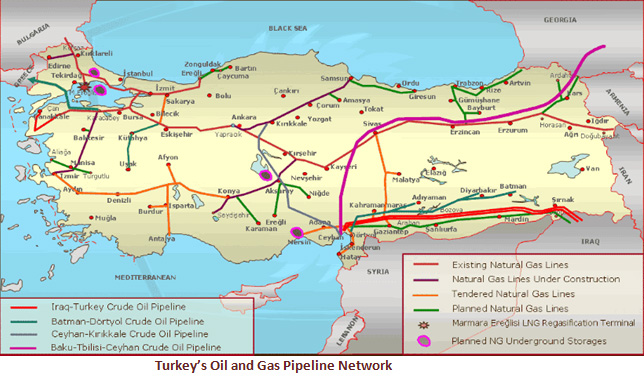
Oil pipelines
(a) The Baku–Tbilisi–Ceyhan (BTC) Oil Pipeline which transports oil from the offshore Azeri-Chirag-Guneshli oil field via Georgia to the Turkish port of Ceyhan for export. That pipeline started operation in 2007.
(b) The Iraq–Turkey (Kirkuk–Ceyhan) Oil Pipeline which is Turkey’s oldest pipeline. It has been in operation since 1977 carrying oil from Kirkuk in Northern Iraq to Ceyhan in Turkey. This 970 km long pipeline has a capacity of approximately 19.9 million tonnes of oil per year
(c) The Trans-Anatolian (Samsun–Ceyhan) Oil Pipeline Project which is under construction and will be operated by the Trans-Anatolian Pipeline Company (TAPCO). This 550 km pipeline will stretch across Turk¬ish territory from the Black Sea (Samsun) to the Mediterranean Sea (Ceyhan) and will carry Russian and Kazakh crude oil
Natural Gas pipelines
(a) The Baku–Tbilisi–Erzurum (BTE) Gas Pipeline also called South Caucasus gas pipeline, transports natural gas from the Sangachal terminal in Baku to Turkey via Georgia. First deliveries through the pipeline commenced on September 2006.
(b) The Iran–Turkey Natural Gas Pipeline started deliveries of gas in 2001, with a capacity of 10 billion m3 of natural gas per year from Tabriz (Iran) to Erzerum (Turkey).
(c) The Blue Stream Gas sub-sea Pipeline was constructed to deliver gas from Stavropol Krai in Russia, under the Black Sea, to the Durusu terminal in Turkey. With a length of 1,213 km, its full capacity is 16 billion m3 of Russian gas per year. It came on stream in 2005
A number of major gas pipeline projects are currently planned which are listed as follows:
(a) The Anatolian Transit Gas Pipeline Project (TANAP) In October 2011 Turkey and Azerbaijan signed a number of agreements regarding prices, supply vol-umes and the transit of gas which Azerbaijan exports to Turkey. It was then agreed that 10 billion m3 of additional Azeri gas supplies would transit Turkey annually and reach the borders of Greece in order to feed with gas the Trans Adriatic Pipeline (TAP).
(b) The Iraq–Turkey Natural Gas Pipeline Project is proposed to run parallel to the Kirkuk–Ceyhan oil pipeline (its length has not yet been specified) and to transport approximately 10 billion m3 of gas per year from the north-eastern part of Iraq to Turkey and feed BOTAS’ system
(c) The Persian Natural Gas Pipeline Project is a natural gas pipeline project planned to carry Iranian gas from the South Pars field to Europe through Turkey. The first step was made in 2008, when Ankara and Tehran signed a Memorandum of Understanding to build the pipeline. However, no much progress has since been reported by either Iran or Turkey.
(d) The Arab Natural Gas Pipeline is a 1,200 km long natural gas pipeline project which is supposed to deliver 10.3 billion m3 of natural gas per year from Egypt to Jordan and Syria into BOTAS system.
(e) The South Stream Natural Gas Pipeline Project will connect Russia with Europe’s consumers by shipping Russian natural gas to Bulgaria and hence to continental and West Europe. The pipeline passes through Turkey’s exclusive economic zone in the Black Sea. This pipeline project, led by Gazprom and Eni, is proposed to have a capacity of 60 billion m3 of gas per year. However, gas from thee South Stream pipeline will not be diverted to Turkey.
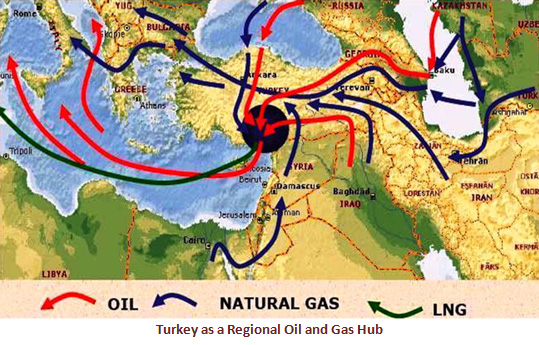
Turkey and the Arab Spring
Yet it would be wrong to think of the recent events in Turkey as another chapter in the "Arab Spring” sequel. Unlike most of countries the region, Turkey has a democratic tradition that goes back to the early 1920’s. The wide spread protests of early June are a sign of rising dissatisfaction with Recep Tayyip Erdogan, Turkey’s most important leader since Kemal Ataturk. For outside observers, Turkey’s recent upheaval is a firm indication that Islam and democracy cannot coexist. As the Economist rightly commented "The real lesson of these events is about authoritarianism: Turkey will not put up with a middle-class democrat behaving like an ottoman sultan”.
On the other hand Mr. Erdogan’s achievements over the last decade cannot be easily ignored. Sticking to the IMF prescriptions that he inherited, he rescued the economy from the meltdown it suffered in 2001. Since then economic recovery has been remarkable. In the past ten years GDP per person has risen by 43% in real terms, inflation has been reduced by 30% to a mere 6.0%, exports have increased nearly tenfold reaching $153 billion in 2012 and foreign direct investment has leapt. Turkey is now the world’s 17th biggest economy. GDP growth has averaged over 5% a year since Mr. Erdogan justice and Development (AK) party took office in late 2002. The GDP per capita which was $3.492 in 2000 is now up above $10.000 The government also pushed through enough reforms to earn the start of membership talks with the European Union in 2005, a prize that had eluded Turkey for 40 years. Mr Erdogan has done more than any of his predecessors to settle matters with his country’s 15m repressed and restless Kurds. Rightly so Turkey has come to be seen as a model for nations emerging from the Arab spring.
However, the recent protest movement and the government's "heavy-handed” response showed that this hard won economic growth and social cohesion could be at risk. The protests broke out at a time when Turkey's economy had started to slow. The economy as a whole is now down from 8.5% growth in 2011 to 2.2% in 2012. On the other hand and beyond the Taksim square riots the flow of large numbers of refugees from Syria into the border provinces has helped undermine the social order in those parts of the country, creating a highly volatile situation.
The decades old conflict between Turkish Kurds and Turkish government has cost more than 40,000 lives and contributed significantly to the periodic social unrest. In 2008 the Turkish parliament legalized private Kurdish language courses and created the first public television channel in Kurdish and in 2009, in a show of courage and good sense, Turkey’s government has further announced a plan to grant long-denied rights to its Kurdish minority. However, the government attracted the wrath of the nationalists, who accused Turkish Prime Minister Recep Tayyip Erdogan of plotting to divide the country.
Unlike most of his predecessors, and supported by the foreign minister, Ahmet Davutoglu, Tayyip Erdogan has embraced Turkey’s Arab neighbours, opening new markets for Turkish contractors and drawing in Gulf Arab investors. Mr Erdogan has also struck an alliance with Iraq’s oil-rich Kurds, a move that has helped pave the way for his bold and ambitious effort to make peace with Turkey’s own Kurds. Mr. Davutoglou’s goal of achieving zero problems with all of Turkey’s neighbours appeared for a time to have a reasonable chance of success. But the peaceful democratic and all encompassing Islamic governance image that Turkey has tried hard to project to restful Arab Spring countries, seem to have misfired. Turkey’s salvoes against Israel, which for a moment pleased the Arab street have raised eyebrows in Washington and London and deprived Turkey of a useful regional partner. Equally Mr. Erdogan’s overt support for rebels fighting to topple Syria’s president, Bashar Assad, whom he wrongly predicted would quickly fall, is growing more unpopular. The economy, too, is lacklustre. Growth has fallen to 3%, and unemployment is stubbornly high (at 9.0%). A large current-account deficit makes Turkey vulnerable to a shift in market sentiment that might easily follow the present unrest. Secular Turks are incensed by what they see as the steady dilution of Ataturk’s legacy. The introduction of Koran classes for primary-school pupils and the revival of Islamic clerical training for middle schools are examples of creeping Islamisation, they say.
Turkey’s Energy Policy Implications
All the above, point to a non sustainable and maybe dangerous social situation in Turkey which, according to the European Union’s declarations, must secure its social cohesion and welfare, grant more rights to ethnic minorities and focus more to European principles and standards before being accepted fully as a member country. Prof. Necdet Pamir, Professor in Bilkent University, in Turkey, noted that a Turkish energy policy consequently should focus not only on the economic, environmental and security dimensions but also on the social dimension. According to Prof. Pamir, economic welfare, peace and environmental preservation can only be secured with a more effective and intelligent use of energy, mainly through the development of renewable energy sources and the introduction of energy efficiency measures.
Apart from its social cohesion, Turkey’s energy security policy suffers from two weak points. Analysts and think tanks such the BST (The Black Sea Trust for Regional Cooperation) claim that Turkey’s extensive use of natural gas in its energy mix and its need to import almost the entire amount make it highly vulnerable. Russia remains Turkey’s main natural gas supplier. Turkey’s purchase of natural gas from Russia increased to 44% in 2011. Disagreements with Iran, the second largest supplier (from where Turkey obtains almost one fifth of its gas supplies), over the price of gas remain unresolved. Turkey is also the biggest customer for Azeri natural gas. According to the BST it is still unclear how Turkey will move beyond being a mere gas importer to becoming a transit country and eventually a game-maker in the international arena. For the last few years, Turkey has been trying hard to implement a comprehensive energy and foreign policy plan by considering the transiting of alternative pipelines. This has not been an easy task as a lot depends on decisions taken by third country governments which do not necessarily share Turkey’s vision of developing a safe energy transit zone.
In this context, a change is noticeable over the last few months in the general approach followed by government and major companies. In terms of policy preferences, a shift from projects that provide cooperation with consumers to projects that aim toward collaboration with producers is obvious. Turkey wants to participate in developing and marketing the large oil and gas resources located in the Caspian Sea region, mainly in Turkmenistan, Kazakhstan, and Azerbaijan many of which are shipped to Western markets via Turkey. These three states, aiming to by-pass Russian territory and reach European energy markets, attach an even greater value to Turkey as a transit corridor for their energy resources. This vital relation with the central Asian countries permits Turkey to use its geographic location to promote its energy strategy and pursue its foreign policy goals.
Given that a number of oil and gas pipelines destined for European consumers pass, or are planned to pass, through Turkey, Ankara is trying to gain much needed political leverage in Europe. According to the Ankara based Centre for Strategic Research (SAM), Greece can help Turkey’s energy strategy by developing joint energy infrastructure projects and the planning of a common regional energy policy. Developing such a cooperation is likely to emerge as one of the key foreign policy challenges and a most crucial factor in Turkey’s aim to gain political influence in Europe and in the region. In relation to the above, and according to many energy analysts in Turkey the prompt opening of energy chapter negotiations, which would help implement Turkey’s energy security policies in close collaboration with the EU, will be able to proceed unimpeded once the conflict between Turkey and Cyprus is overcome. Hence, the latest interest by USA, Turkey and Greece to go for one more round of UN sponsored Cyprus talks next autumn.
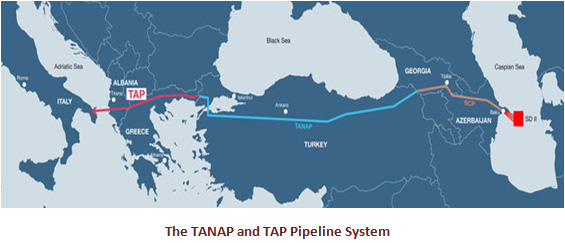
Turkey right now is in the process of constructing a significant network of oil and gas pipe¬lines connecting it to the major energy producers in the Caspian, the Middle East and Russia, with completed pipe¬lines such as BTC, BTE, South Caucasus, Blue Stream, the Kirkuk–Ceyhan oil pipeline (under contraction) and the Tabriz–Erzurum gas pipeline, and pending projects like TAP, TANAP, the Persian natural gas pipeline, the Arab natural gas pipe¬line and the Trans-Anatolian oil pipeline. Turkey’s current energy policy also favours the construction of alternative routes bypassing the Dardanelles for oil and natural gas volumes which move across the country. In addition it is expanding the necessary infrastructure in its Mediterranean port of Ceyhan transforming it into major energy and shipping hub. It is apparent that, the pursued energy strategy is aiming towards the emergence of Turkey as the region’s key energy player securing essential transit routes for oil and gas to Europe and energy distribution centres of global significance. In that sense, Turkey has already achieved the greatest part of its energy goals.
Nevertheless, with the possible exception of the Dardanelles strait a direct link to Europe is still missing. The implementation of the TANAP pipeline in conjunction with the TAP pipeline might change this situation, but until then it is difficult to say that Turkey has achieved its aim of becoming the main East-West energy corridor to Europe. Apart from the spectre of social instability that Turkey potentially faces, the present turmoil in the Middle East, especially in Iraq, Syria and Egypt, as well as Iran’s nuclear ambitions and the Nagorno-Karabakh conflict, all contribute to rising regional instability which may help undermine the certainty and security of the energy corridors that originate or pass through Turkey.
An Alternative Energy Route and the East Mediterranean Gas Findings
The above analysis may give a false impression that Turkey is unique in securing the vital energy routes to Europe. However, latest natural gas findings in offshore Israel and Cyprus can help reshape the regional energy map and rapidly transform the Eastern Mediterranean into to a world-class natural gas producer. The various hydrocarbon exploration and development projects currently under development in both Israel and Cyprus and the launching of joint projects in the energy sector between these two countries and Greece point to the emergence of a new Eastern Mediterranean energy corridor which has the potential of tipping the whole political and economic balance of the region by providing direct and alternative energy supplies to the EU, by passing at the same time non EU members. Thus, in terms of international politics and associated energy security issues, it is becoming increasingly clear that a geo-political block along the Greece-Cyprus-Israel axis is likely to play a key role in European energy supply.

Following the disruption of its diplomatic ties with Turkey and the interruption of gas supplies from Egypt, Israel turned to Cyprus and Greece, for diplomatic and strategic support as these two countries can play an important role in securing a much needed energy bridge to Europe. In the case of Greece the country can provide the much sought after strategic depth that Israel needs, and in a way Turkey had offered until recently. The Israeli and Greek Cypriot administrations began cooperating closely on energy and developing further their diplomatic ties soon after the American oil company Noble Energy discovered gas in Cyprus’s EEZ. At the same time Cyprus is in the process of confirming through a secondary drilling process, the discovery of about 7.5 trillion cubic feet of gas in the Aphrodite block (block 12), currently in progress, adjoining one of Israel’s main gas fields the Leviathan situated just 60 kms East. Further exploratory drillings are expected soon by Italy’s ENI and South Korea’s Kogas consortium and also by French company Total. Israel has so far discovered at least 24 trillion cubic feet of natural gas in two marine blocks. Most of Israel’s gas is contained in two offshore fields in the Mediterranean Sea: Tamar, which began production in March 2013, and Leviathan, about twice Tamar’s size. It is interesting to note that between them Israeli and Cyprus proven gas reserves are almost equal to those of Azerbaijan at 31.5 tcf.
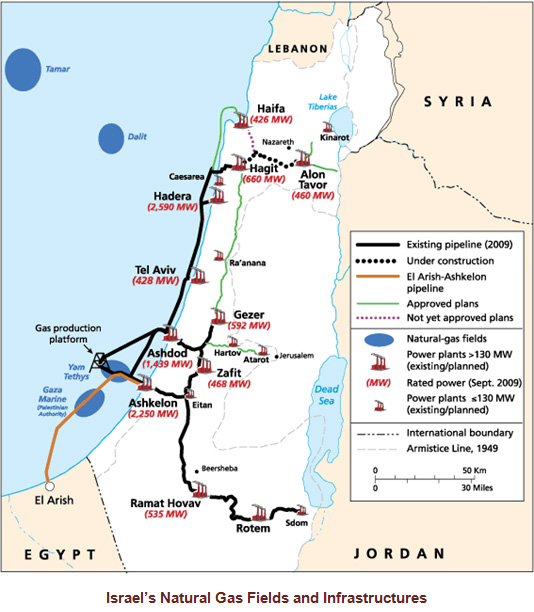
On August 8, 2013 the Greek and the Cypriot governments intend to conclude agreements with Tel Aviv on energy security by signing an MoU on energy cooperation and paving the way for joint mega – projects in energy such as the Cyprus based Liquefaction Plant, the East Med Pipeline, and the EuroAsia interconnector, a giant electricity cable. The priority for Cyprus and Israel is to build first a liquefaction terminal near the Vassilikos area. A pipeline to link Cyprus to Crete and then to mainland Greece or Italy has some distinct advantages for Europe. LNG, which can be shipped anywhere in the world, is typically sold to the most lucrative market. But a pipeline would guarantee that adequate gas supplies reached directly EU consumers. According to the Cypriot government the European Union has decided to include the East Med Pipeline in its revised list of projects of common interest.
In addition a pipeline between Israel and Cyprus’s gas fields and mainland Turkey, and provided that ample gas supplies have been secured, cannot be excluded as it will provide one more gas input to Turkey’s craving gas market. Such a pipeline because of its relatively small length can make economic sense with both Cyprus and Turkey benefiting from its operation.
While the LNG option usually comes first in official speeches, exporting gas by pipeline from Israel and Cyprus could provide an interesting option as a way of consolidating relations with neighbouring states. The main factor is therefore political, as the pipeline option helps to strengthen political and economic autonomy, enabling countries to choose their own foreign policy and security orientation. As a result, a pipeline may become easily a significant regional factor.
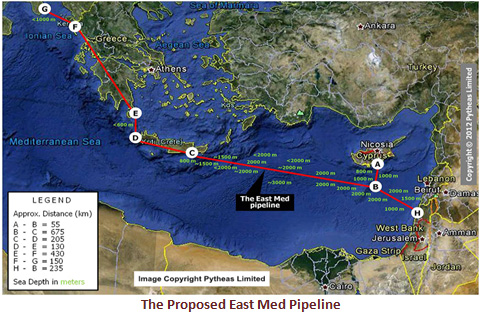
However, energy cooperation between the above three countries does not need to stop here. The EuroAsia Interconnector, the world's longest submarine electricity cable reaching 1,150 km at a depth of 2000 meters and delivering 2000 MW, is set to be built between Israel, Cyprus and Greece, according to an agreement signed on March 4th 2012, in Haifa. Electricity lines will run from Israel to Cyprus (300km) to Crete (600 km), and then to mainland Greece (250 km), enabling the connection to the European electricity system. Thanks to this project Greece’s role in the European energy chessboard is to be upgraded, while Cyprus will be able to secure the in-and-out energy flows it now lacks. Israel, in turn, can become a major energy provider to the European continent and strengthen significantly its own energy sustainability.
However, this energy corridor between Israel, Cyprus and the rest of Europe, which includes megaprojects in gas and electricity, is still largely on paper and at MoU level. Besides the technical, financial and diplomatic difficulties that might arise from such kind of interregional projects, this alternative corridor even if it comes to life at some late stage, it will never really replace the energy transit role of Turkey but it would assume a complimentary role.
The important question now is whether there will be peace and stability in the region. Tranquillity is a clear precondition that will enable cooperation and the formulation of a common regional strategy among the countries that can constructively participate in the energy corridors of Eastern Mediterranean (i.e. Turkey, Greece, Israel and Cyprus). Only through such cooperation energy security in Europe, and SE Europe in particular, can be ensured for the benefit of all involved.
(source: IENE’s SOUTH-EAST EUROPE ENERGY BRIEF- Monthly Analysis, Issue No 103 • July-August 2013)
